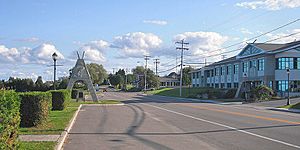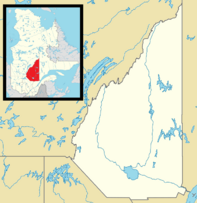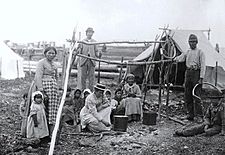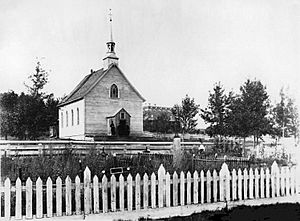Mashteuiatsh facts for kids
Quick facts for kids
Mashteuiatsh
|
|
|---|---|
 |
|
| Country | |
| Province | |
| Region | Saguenay–Lac-Saint-Jean |
| RCM | None |
| Formed | September 6, 1856 |
| Area | |
| • Total | 15.20 km2 (5.87 sq mi) |
| • Land | 14.43 km2 (5.57 sq mi) |
| Population
(2021)
|
|
| • Total | 2,010 |
| • Density | 139.3/km2 (361/sq mi) |
| • Change (2016–21) | |
| • Dwellings | 1,095 |
| Time zone | UTC−5 (EST) |
| • Summer (DST) | UTC−4 (EDT) |
| Postal Code |
G0W 2H0
|
| Area code(s) | 418 and 581 |
Mashteuiatsh is a special community for First Nations people in Quebec, Canada. It is located about 6 kilometres (3.7 mi) north of Roberval. This reserve is the home of the Pekuakamiulnuatsh First Nation, who are part of the Innu people.
The community sits on a piece of land that sticks out into Lake Saint-Jean. This area is also known as Pointe-Bleue. Mashteuiatsh has many services for its people. These include a health centre, a local radio station, an arena, and a library. There is also a community and sports centre, social services, and a fire station. The community even has its own police force.
Mashteuiatsh is also home to the Mashteuiatsh Amerindian Museum. This museum was started in 1977. Its main goal is to keep the Innu culture and history alive and share it with others.
Contents
What's in a Name?
The name Mashteuiatsh comes from Ka Mesta8iats. It means "where there is a point" or "seeing one yet again at the point." This name describes the land that sticks out into the lake.
Before 1856, this place was already important to the Ilnuatsh people. They used it as a gathering spot and a place to pass through. The community was first called Ouiatchouan. But in 1985, it was officially renamed Mashteuiatsh. Many people also used the popular name Pointe-Bleue for a long time. Most members of the Pekuakamiulnuatsh First Nation live in this community.
Where is Mashteuiatsh?
Mashteuiatsh is an Indian reserve located right by the towns of Roberval and Saint-Prime. It is on the shore of Lac Saint-Jean in the Saguenay–Lac-Saint-Jean region of Quebec.
The community is about 68 kilometres (42 mi) west of Alma. It covers an area of about 1,443 hectares (3,570 acres). A road called Boulevard Horace-J.-Beemer connects Mashteuiatsh to Roberval in the south.
A Look Back in Time
Long before Europeans arrived, this area was a common stop and camp for the Innu people. Around 1775, a trading post was set up here by English merchants.
In 1853, a government official suggested setting aside land for the Innu. The Innu living near the Peribonka River were offered 16,000 acres (6,500 ha). Those near Métabetchouan were offered 4,000 acres (1,600 ha). However, Pointe-Bleue was their traditional home. Also, loggers were not respecting the boundaries of the new lands. So, the Innu asked the Canadian government to trade those lands for the area where Pointe-Bleue is.
This request was approved in 1856. The Innu were given 23,040 acres (9,320 ha) of land. This area became known as the Ouiatchouan Reserve.
In 1867, the Hudson's Bay Company opened a trading post here. This made the reserve more important. It even led to a mission being set up by the Oblates in 1875. The trading post in Métabetchouan closed in 1880 because of this.
However, the Innu were not very interested in settling permanently. Also, politicians and religious leaders wanted new settlers to move into the area. Because of this pressure, the Innu gave back more than 15,000 acres (6,100 ha) of land to the government in 1869. They gave back another 2,400 acres (970 ha) in 1895. The reserve became even smaller in 1901 when more land was sold. It shrunk again in 1911 when a railway was built through it. In 1933, the Duke Price Power Company raised the water level of Lake Saint-Jean. This left only the lands right next to the lake.
In 1985 and 1986, the Lac St-Jean Innu started asking for their lost lands back and for payment. On February 28, 2000, they signed an agreement with the Government of Canada.
Mashteuiatsh Native Museum
The Mashteuiatsh Native Museum was built in 1977. Its goal is to share the history and culture of the Pekuakamiulnuatsh (Ilnus of Lac-Saint-Jean). At the museum, you can learn about the Ilnuatsh people. You can also discover more about other First Nations in Quebec and across America.
Besides its main exhibits, the museum has three changing exhibits. You can also visit the Nutshimitsh outdoor garden, which is in the forest. The museum offers art workshops and has a gift shop. Community members often lead guided tours of these activities.
Community Numbers
| Canada census – Mashteuiatsh community profile | |||
|---|---|---|---|
| 2016 | 2011 | 2006 | |
| Population: | 1,957 (-11.6% from 2011) | 2,213 (26.5% from 2006) | 1,749 (-6.0% from 2001) |
| Land area: | 14.51 km2 (5.60 sq mi) | 14.50 km2 (5.60 sq mi) | 14.50 km2 (5.60 sq mi) |
| Population density: | 134.9/km2 (349/sq mi) | 152.6/km2 (395/sq mi) | 120.6/km2 (312/sq mi) |
| Median age: | 37.5 (M: 37.1, F: 38.3) | 35.8 (M: 35.8, F: 35.7) | 33.4 (M: 33.4, F: 33.5) |
| Total private dwellings: | 1,022 | 1,005 | 982 |
| Median household income: | $49,216 | $NA | $36,736 |
| References: 2016 2011 2006 earlier | |||
In 2022, the First Nation band had 8,373 members in total. About 2,104 of these members live in the Mashteuiatsh community.
Here's how the population has changed over the years:
- Population in 2021: 2,010 (a 2.7% increase from 2016)
- Population in 2016: 1,957
- Population in 2011: 2,213
- Population in 2006: 1,749
- Population in 2001: 1,861
- Population in 1996: 1,725
- Population in 1991: 1,489
There are 808 homes in the community where people live regularly. The total number of homes is 1,095.
Most people in Mashteuiatsh speak French as their first language (87.1%). About 9.5% speak another language first, and 0.8% speak English first.
What People Do for Work
The local economy in Mashteuiatsh mainly involves logging (cutting down trees), construction, transport, and tourism.
There are about 130 businesses in the reserve. These businesses offer many different services. Some examples include:
- Food stores and restaurants
- Hotels and places to stay
- Sawmills (where wood is cut)
- Electricians and auto mechanics
- Taxi services
- Shops for arts and handicrafts
- A post office
- Excavation services
- Plumbers
- Translation services
- Camping sites
- Hardware stores
- Convenience stores
Learning and Schools
There are two schools located within the Mashteuiatsh reserve:
- École Amishk: This school teaches children from pre-Kindergarten up to elementary grade 6. In 2008-2009, it had 247 students.
- École Kassinu-Mamu: This school is for older students, providing secondary grades 1 to 5. In 2008-2009, it had 230 students.




